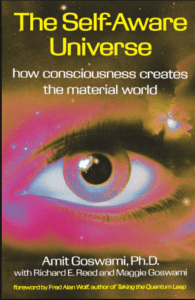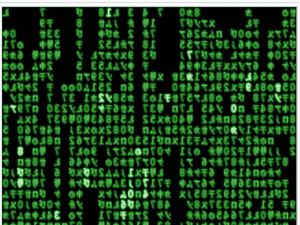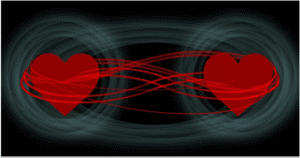Some of the basic principles of quantum physics fit well with the Buddhist and New Age ideas that physical matter and energy arise from consciousness. However, there is also a misunderstanding of the relationship of quantum physics and consciousness (in regard to the notion of an “observer”) that I will address later in this answer.

The Universe Works in Accordance with Math
A basic principle of quantum physics is that elementary particles like electrons can be completely described mathematically.* For example, an electron has a charge of minus 1, a mass of 1/1836 that of the proton, and so on. Every electron is identical to every other electron and can be described by these same numbers. You don’t need a sample of an electron to give it a complete description. It’s as if electrons are just pieces of math. The same is true for every photon (a particle of light), every proton (a particle of matter), and so on for all the tiniest particles of matter and energy.
This isn’t like the flavor of a cherry or the color of a sunflower. No amount of mathematical description would suffice to communicate how a cherry tastes nor how the color of a sunflower looks. For these, you need to provide a sample which can be experienced.
A cherry is made up solely of electrons, protons, photons, etc. And these tiny bits are just a bunch of math. So, why does the flavor of a cherry go beyond math? Why do we have the physical experience of the sharp, sweet taste of a cherry? A spiritual interpretation would be that the cherry taste is the conscious experience of quantum-level mathematical descriptions. It is the experience that our consciousness assigns to a particular mathematical expression.

The same is true for color. The yellow color of the sunflower is not inherent in the photons coming from the sunflower. Photons which have a middle-range frequency shoot from the sunflower into our eyes.* These photons are vibrating very quickly, but they’re not vibrating very “yellowly.” Photons which have the right frequency stimulate our brains and create a specific brainwave pattern. And consciousness experiences that brainwave pattern as yellow.

The mathematical descriptions of electrons, photons, and their interactions are like the mathematics of computer code. This mathematical coding shows up as pixels lighting up on a computer screen. And consciousness looks at the screen and experiences, for example, characters shooting each other in a video game. That mathematical coding creates physical reality is the premise of the movie, “The Matrix.”
Going further, one can ask, who or what created all the mathematics that describes quantum particles and their interactions? One possible answer is: no one, it’s all just an incredible series of accidents. Another answer is that God is a mathematician. (Or one can substitute for “God” whatever name one wants to call the consciousness of all that is.) The notion that physical reality accords with mathematics and arises from consciousness was popular among early quantum physicists. Max Planck, Nobel Laureate, whose work launched the field of quantum physics, expressed this in a famous quote (see illustration).
We live in a physical universe that many physicists believe will one day be fully described by mathematics. Yet, we don’t experience the physical universe as a bunch of mathematical expressions and equations. And we don’t experience it as computer code. Possibly, we perceive the math or the coding, and our consciousness gives it meaning—the sharp, sweet taste of the cherry and the yellow of the sunflower. It’s like a computer programmer creating a program for the video game that he can, then, play and experience.
Entanglement and the Unity of All Things

Physics experiments have ruled out the possibility that the two electrons are pre-programmed. If the entangled particles were pre-programmed, they would come in matched pairs, like if one glove is for the right hand, the other, of course, is for the left. However, experiments have ruled out this explanation. Physicists have not come up with a theory to explain entanglement. Possibly, such a theory could derive from the spiritual principle that, at bottom, all things are one.
Other Aspects of Quantum Physics Which Relate to Spirituality
Several other key aspects of quantum physics fit well with spiritual principles. Perhaps, the most important is that quantum particles are in a state of potentiality, possibly having this property and possibly becoming having that property, until they interact with some aspect of the physical universe. Only then, do they enter our physical reality as a particle with definite properties. This aspect of quantum physics may connect with the spiritual idea that our intentions, conscious or subconscious, causes potential realities to manifest. For more on this aspect of quantum physics, read about Quantum Field Theory.
The Observer and Quantum Physics
But I would like to address a misinterpretation of quantum physics that some people say “proves” that human consciousness is essential to the existence of matter and energy.
Sometimes, people say that the importance of the “observer” in quantum physics tells us that without human consciousness, quantum particles would not have physical reality. As quantum particles are the sub-microscopic level of matter and energy, this requires that the physical reality of matter and energy depends upon human consciousness.
This kind of statement is based on a misunderstanding of the term “observer.” Quantum physicists use the term “observer” to mean something that a quantum particle interacts with. This might be a particle in the experimenter’s eye or just another quantum particle. For example, when a photon (a particle of light) is absorbed by an electron (a particle of matter), an exchange of information and energy occur: the photon disappears, and the electron becomes more active. When this happens in a solar panel, electricity is generated. The physicist would say that the electron is the observer and has “observed” the photon. Odd terminology, I know.
Prior to the absorption of the photon by the electron, the photon has no specific position in the universe and has other undetermined properties. Upon absorption by the electron, its position and other physical properties become concrete. They become a part of the history of the physical universe. So, the role of the observer in quantum physics is critical to creating physical existence, but the observer need not involve human consciousness.***
Conclusion
Principles of quantum physics do not prove that human consciousness or any consciousness is essential to creation of our physical universe. But some of the principles of quantum physics accord well with certain basic spiritual principles of Buddhism and New Age philosophies.
*Yellow light is electromagnetic radiation with a frequency of 510-540 Terahertz. Terahertz means 10 to the power of 12 oscillations per second. Suffice it to say, that’s many, many.
**For more information, read Our Mathematical Universe by noted quantum physicist, Max Tegmark.
*** For more information, read Understanding Our Unseen Reality: Solving Quantum Riddles, by Ruth E. Kastner, quantum physicist.
